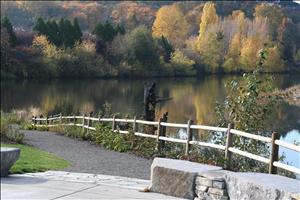On May 13, 2017, Tukwila officials and residents celebrate the completion of the city's Duwamish Gardens Project, which converted a historic homestead site on the Duwamish River into a park with enhanced salmon habitat. The property, at 11269 East Marginal Way S, had been a truck farm called Duwamish Gardens for much of the twentieth century. And it had held a pioneer farmhouse that was one of the lower Green-Duwamish Valley's last remaining pre-1900 structures until its 2015 demolition.
Duwamish Gardens
The historic house was built by Thomas K. Ray (1852-1940), along with a barn and other structures. He established the truck-farming operation that came to be called Duwamish Gardens. The property next was owned by a group of Italian immigrants led by Joseph Carrossino (1891-1956). They ran the business for decades. Joseph and his wife Teresa (1895-1985) also made the old farmstead the social center of the local Italian American community by hosting weekly Sunday get-togethers.
The area around Duwamish Gardens was primarily agricultural until the 1960s, when zoning and tax-code changes caused the gradual closing of many farms, giving way to other commercial and residential development. Teresa Carosino (as the family came to spell the name) was the last of the original Duwamish Gardens partners, selling vegetables there until her death in 1985. In 2008 the city of Tukwila bought the property from the Carosino family. Efforts to move the old farmhouse away from the elevated light-rail line erected earlier in the decade (part of the Sound Transit line from downtown Seattle to Sea-Tac Airport) failed, and the building was demolished in 2015.
Creating Habitat for Juvenile Salmon
Tukwila's plan for the Duwamish Gardens property was to create shallow-water habitat for juvenile salmon while also preserving a part of local history. Partners helping the city buy the site included the Washington State Recreation and Conservation Office, the Salmon Recovery Funding Board, Washington State Aquatic Lands Enhancement Account Grant, Water Resource Inventory Area 9, King Conservation District, King County Conservation Futures Program, and Washington State Department of Fish and Wildlife.
The project involved excavating about 30,000 cubic yards of soil to create mudflat and marsh -- shallow areas in the transition zone where salt water and fresh water mix. Such brackish habitat is essential to the growth of young salmon, giving them a safe place to feed and rest while they develop lungs and gills, and grow big and strong enough to migrate out into Puget Sound.
The Muckleshoot, Snoqualmie, Stillaguamish, Suquamish, and Tulalip tribes participated in the project, which is within the Epic of the Winds Traditional Cultural Property.
Remembering the Past
The resulting 2.18-acre park contains about an acre of that shallow-water habitat. Designed to be a passive park (one that preserves natural habitat and has a low level of development), its gravel footpaths have occasional granite-slab benches and lead to understated features -- a modest overlook and gathering circle, a hand-carry boat launch, and a shoreline walk ending with a wind-chime sculpture representing the racks used by Coast Salish people to dry salmon and game.
Interpretive panels tell the history of the site including the presence of Coast Salish people on the river for more than 2,000 years, and the settlers and immigrant farmers who followed. Other panels focus on the area's fish and plants, as well as the benefits of rain gardens.
The dedication celebration on May 13, 2017, did not mean the end of work along that stretch of the river: Plans called for the creation of more salmon habitat in a bigger park to be built immediately to the west of the Duwamish Gardens site. Tentatively named Chinook Wind, that park would extend west to Tukwila International Boulevard and be linked by paths to the Duwamish Gardens Project.
There was already additional park land a short distance east of Duwamish Gardens. After the ceremony there, participants crossed East Marginal Way South to recognize the expansion of Duwamish Hill Preserve, another park-like setting that includes Beaver Lodge or Grandmother's Hill, a site that is part of the Duwamish creation story. That park also includes a bench with a drawing of the Ray-Carrossino house, which describes Duwamish Gardens as "the soul of the Italian immigrant community."

